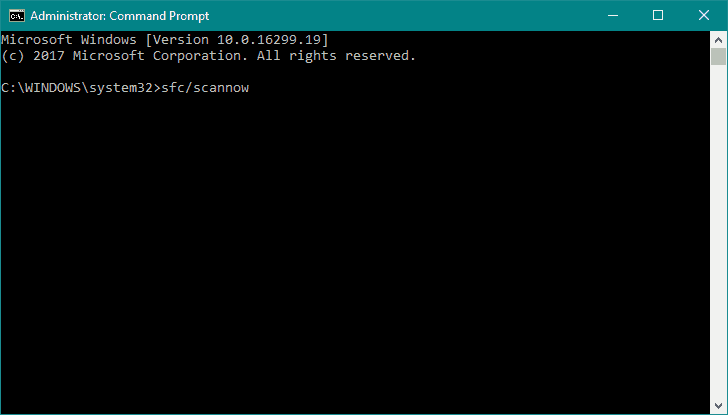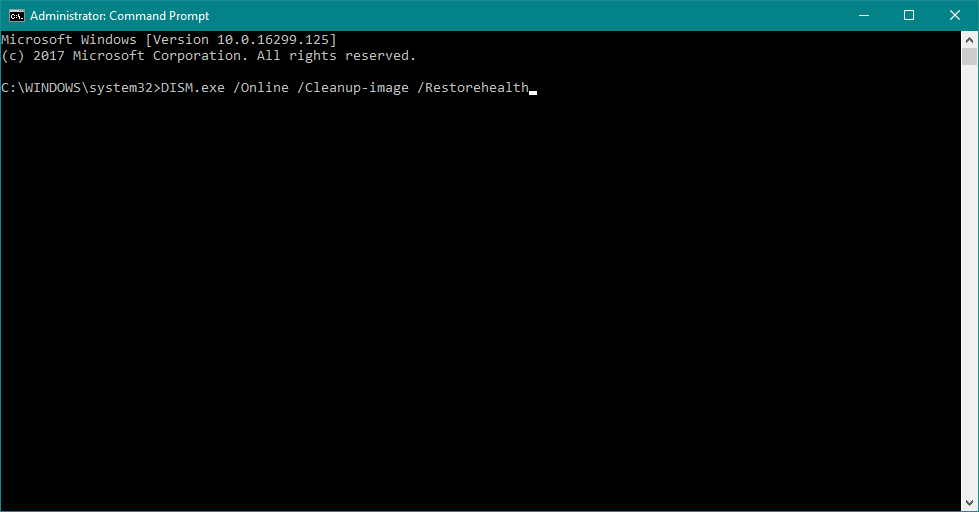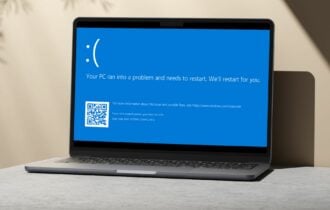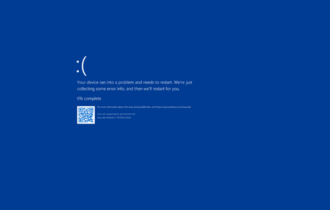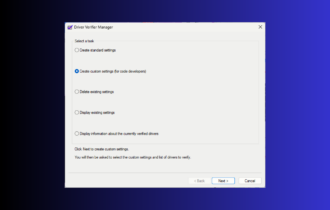Full Guide: NO SUCH PARTITION error in Windows 10
9 min. read
Updated on
Read our disclosure page to find out how can you help Windows Report sustain the editorial team Read more
Key notes
- Rather often these types of errors are caused by a faulty or outdated driver, so in order to fix these errors it’s crucial that you keep your drivers up to date.
- The next step is to use the troubleshooter, that can deal with various problems, including the BSOD issues. Read below how you can do that.
- The BSoD can be troublesome because you can't go anywhere until you fix them. Consider our Troubleshooting BSoD section like a shortcut to fix any such problems.
- Fixing Windows 10 errors is our job and we got pretty good at it. Visit our Windows 10 errors hub for a myriad of solutions.

There are all sorts of Blue Screen of Death errors available, and these types of errors can be rather troublesome on Windows 10.
Since BSoD errors are so notorious, today we’re going to show you how to fix NO SUCH PARTITION error.
How can I fix NO SUCH PARTITION BSoD error?
- Make sure your drivers are up to date
- Run the BSOD Troubleshooter
- Run the SFC scan
- Run DISM
- Check the hard drive
- Fix MBR
- Manually configure the active partition
- Restore the boot sector code
- Check for hardware problems
- Reinstall Windows 10
Fix – NO SUCH PARTITION Windows 10 error
Solution 1 – Make sure your drivers are up to date
Rather often these types of errors are caused by a faulty or outdated driver, so in order to fix these errors it’s crucial that you keep your drivers up to date.
Updating drivers is relatively simple, and all that you need to do is to visit your hardware manufacturer and download the latest drivers for your device.
Bear in mind that you’ll have to update as many drivers as you can, so the update process might become a bit tedious.
Update drivers automatically
Searching for drivers on your own can be time-consuming. So, we advise you to use a tool that will do this for you automatically.
Using an automatic driver updater will certainly save you from the hassle of searching for drivers manually, and it will always keep your system up to date with the latest drivers.
A dedicated tool will help you update drivers automatically and prevent PC damage caused by installing the wrong driver versions.
After several tests, our team concluded that the professional driver updater Outbyte Driver Updater is the best-automatized solution.
It works with all versions of Windows and makes upgrading drivers a breeze. Outbyte Driver Updater may be set to discover outdated drivers automatically.
This solution has a large daily-updated driver database, so it will propose the most recent drivers available after scanning your system.
You will also receive a comprehensive report outlining the precise state of your Windows 10’s missing, damaged, or obsolete drivers. However, a program like Outbyte Driver Updater not only downloads and installs drivers, but also manages them by troubleshooting, backing up, and restoring them.
Solution 2 – Run the BSOD Troubleshooter
Now, we’re going to turn to Windows 10’s own troubleshooting tools. The first tool we’re going to seek help from is the unified troubleshooter.
This tool can be used for dealing with various problems, including the BSOD issues.
Here’s how to run the BSOD troubleshooter in Windows 10:
- Open the Settings app and go to Update & Security section.
- Select Troubleshoot from the menu on the left.
- Select BSOD from the right pane and click Run the troubleshooter.
- Follow the instructions on the screen to complete the troubleshooter.
Solution 3 – Run the SFC scan
The next troubleshooting tool we’re going to run is the SFC scan. This is a command-line troubleshooter that scans your system for potential issues, and resolves them (if the solution is possible, of course).
Here’s how to run the SFC scan in Windows 10:
- Right-click on the Start Menu button, and open Command Prompt (Admin).
- Enter the following line and press Enter: sfc/scannow
- Wait until the process is done (it may take a while).
- If the solution is found, it will automatically be applied.
- Now, close the Command Prompt and restart your computer.
Solution 4 – Run DISM
The final troubleshooting tool we’re going to try here is DISM.
Deployment Image and Servicing Management freshly deploys the system image, so it’s possible it will wipe away the potential BSOD issues.
We’ll walk you through both standard and the procedure that utilizes the installation media below:
- Standard way
- Right-click Start and open Command Prompt (Admin).
- Paste the following command and press Enter:
- Wait until the scan is finished.
- Restart your computer and try updating again.
- With the Windows installation media
- Insert your Windows installation media.
- Right-click the Start menu and, from the menu, choose the Command Prompt (Admin).
- In the command line, type the following commands and press Enter after each:
- dism /online /cleanup-image /scanhealth
- dism /online /cleanup-image /restorehealth
- Now, type the following command and press Enter:
- DISM /Online /Cleanup-Image /RestoreHealth /source:WIM:X:SourcesInstall.wim:1 /LimitAccess
- Make sure to change an X value with the letter of the mounted drive with Windows 10 installation.
- After the procedure is finished, restart your computer.
Solution 5 – Check the hard drive
BSODs usually occur when there’s a problem with your hard drive. To see if that’s the case, run the chkdsk command.
This command will scan your drive, and resolve potential issues (if possible).
Here’s how to run the chkdsk command in Windows 10:
- Enter the Advanced Startup (Restart your computer while holding the Shift key).
- Choose Troubleshoot > Advanced Options.
- Select Command Prompt from the list of options.
- When Command Prompt appears, enter the following lines and press Enter after each line in order to run it:
- bootrec.exe /rebuildbcd
- bootrec.exe /fixmbr
- bootrec.exe /fixboot
- Some users are also suggesting that you need to run additional chkdsk commands as well. To perform these commands, you need to know drive letters for all your hard drive partitions. In Command Prompt you should enter the following (but remember to use the letters that match your hard drive partitions on your PC):
This is just our example, so keep in mind that you have to perform chkdsk command for every hard drive partition that you have.
- Restart your computer and check if the issue is resolved.
Solution 6 – Fix MBR
NO SUCH PARTITION error is commonly caused by the change in Master Boot Records, but fortunately for you, this can be easily resolved.
MBR holds all the information regarding logical partitions and file systems, therefore it’s crucial for your hard drive. In order to fix this problem, you’ll need to do the following:
- Restart your computer while Windows 10 boots. Repeat this step few times in order to start Automatic Repair.
- Choose Troubleshoot > Advanced Options > Command Prompt.
- Once Command Prompt starts, you’ll need to enter the following lines and press Enter after each line in order to run it:
- bootrec /fixmbr
- bootrec /fixboot
- bootrec /rebuildbcd
- Close Command Prompt and restart your PC.
Bear in mind that you might need to use Windows 10 installation DVD or USB flash drive to complete the step.
If you don’t have Windows 10 DVD or USB flash drive, you can use Media Creation Tool to make it.
Solution 7 – Manually configure the active partition
You can get NO SUCH PARTITION error if the active partition isn’t set properly, and in order to fix this problem, you’ll have to manually set it by following these steps:
- Start the Automatic Repair process. For detailed instructions, check the previous solution.
- Select Troubleshoot > Advanced Options > Command Prompt.
- Once the Command Prompt starts, enter the following:
- diskpart
- list disk
- Now you should see the list of hard drives that you have. You need to select the hard drive that has Windows 10 on it. In our example we have just one hard drive, but if you have more of them be sure to select the correct one. Enter select disk 0 and press Enter. Again, we used disk 0 in our example, but you need need to select the disk that has Windows 10 installed on it.
- Enter list part. You should see the list of all partitions on your hard drive.You need to locate the partition that has Windows 10 on it. In our case it’s Partition 1, but it might be different for you, so be sure to use a different number that matches your partition. Enter select partition 1.
- Enter the following lines:
- active
- quit
By doing that, you made your Windows 10 partition active, and the problems with NO SUCH PARTITION should be fixed.
Solution 8 – Restore the boot sector code
To complete this step you’ll need a Windows 10 DVD or USB flash drive so be sure to create one. To restore boot sector code, do the following:
- Connect the USB flash drive or insert Windows 10 DVD to your PC.
- While your PC boots, restart it couple of times. This will start Automatic Repair process.
- Select Troubleshoot > Advanced Options > Command Prompt.
- Enter the following lines:
- Diskpart
- Select disk 0
- List volume
- Locate DVD-ROM or your USB flash drive in the table and remember its letter.
- For this step you’ll need to use the letter that matches your DVD drive or USB flash drive. In our case, it was E, but it will be different on your PC, so be sure to use the appropriate letter.
- Enter the following into Command Prompt:
- Exit
- E:
- Cd boot
- Dir
- Check if you have bootsect.exe in the list of files. If so, enter the following commands:
- bootsect /nt60 SYS /mbr
- Exit
- Restart your computer.
Solution 9 – Check for hardware problems
NO SUCH PARTITION error can be caused due to a faulty hard drive or some other hardware error, so if you’re having this problem be sure to check if your hard drive is properly connected.
A number of users reported that connecting the hard drive to a different port on the motherboard fixed the problem for them, so you might want to try that.
If that doesn’t help, you might have to check if other hardware components are working correctly.
Solution 10 – Reinstall Windows 10
If other solutions didn’t fix this problem you’ll have to reinstall Windows 10. We have to mention that reinstalling Windows 10 will delete all files and folders from your C drive, so be sure to back them up.
To reinstall Windows 10, you’ll need to create a Windows 10 USB or DVD and boot from it.
Follow the instructions and be sure to format your hard drive partition.
NO SUCH PARTITION error can be troublesome, but just like many other BSOD errors, this one can be fixed by following one of our solutions.


